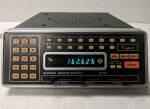I have had they now have changed there minds and bought a Icom R8600 as its a far better build than the 5700D but as we all know it lacks digital modes and does not even decode DMR
The only Digital Modes the 8600 lacks are DMR (a seriously bad decision by Icom) and the much desired, but hopelessly encrypted TETRA (when hoping to listen to the 'interesting frequencies that is).
I have an ARDV1 and the Icom R8600. Both are very good, and certainly the 8600 is very well designed and operates superbly. Connecting the DV! via the 8600's 10.7 MHz output is very easy. Using the 8600 as the 'front end' means all the DV1's Modes and other options can be utilised.
I do not think it is a particularly economic or to be honest a sensible decision just to consider using the DV1 as an 'add on'. Most of the time I use them individually, but the ability to link them is interesting too.
Under normal circumstances the DV1 has to be tuned exactly to 10.7 MHz when the Radios are linked. However the Icom output is versatile enough to allow tuning the DV1 up to at least 2 MHz either side, and still being able o pull in signals very well from the 8600. A sort of extra 'band spread' it could be described as.
I have done this on numerous occasions, but there is one down side. All one sees on the DV1's screen is the frequency in the 10 MHz range, so tuning up and down with it does not give the actual frequency it is pulling in from the 'static' frequency displayed on the R8600.
For example, if the Icom is tuned to 144.5, and the DV1 to 10.7, then via the AR-DV1 one hears what is happening on 145.5.
So if one decides to tune the DV1 to say 9.7 on its screen, in fact it is then receiving what the Icom is hearing on 144.5.' whilst the 8600 still actually tuned to 145.5). So I decided to write an add-on for eSPYonARD, and with that one can see the actual frequency of the Icom signal that the DV1 is pulling in.
One complaint some have about the 8600 is its lack of very small tuning steps, however this can be achieved by the above method using the AR-DV1's tuning steps, which is an added bonus for those who require it on occasions. Without the ability to actually have a visual readout of the 'band spread' frequency being monitored it would really only be an academic exercise naturally, but with the Program's extra DV1 function then one can see the 'real' frequency of the Icom's output.
As others will know from my posts, I agree AOR's fall from grace is very sad indeed. The DV1 remains a great Receiver, whilst AOR's two later Radios leave much to be desired, with no real apparent impetus by AOR to correct the issues. I can only wish AOR one day gets its head together and decides its reputation is more important than blanket denials of any faults. Its future is likely to depend on that change of perception. One can only hope (SIGH).




